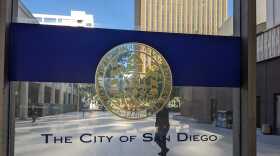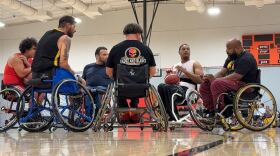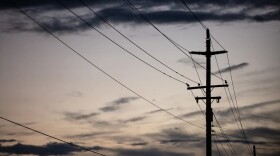This is the midday edition. (Boulevard is the busiest streets. It is where the city is planning growth. A number of high density projects are underway on the Boulevard. That is placing it at the center of a debate over how to adapt our streets to improve pedestrian and bike safety and encourage car free transportation. The Metro reporter has the story. It is a cold sunny Monday. We are meeting in city Heights. Ramp works at a bike shop in North Park and ride his bike every day. He likes not having to look for parking and he says biking is affordable. I try to avoid streets where they are driving faster. He says sometimes large street are unavoidable. He says this especially bad. It is one of the most intense street bike on. There is a lot of cars turning right and not paying attention. You have to be careful. He was disappointed to hear about the city's plan to redesign a section of a cappella Boulevard. The complete Boulevard study due out this month looked at 14 different design alternatives with varying degrees of improvements for bikes, pedestrians and public transit. Final design has no protected by claims, only a painted blame on one side of the street. This is being proposed as a compromise. It is being compromised is safety. This is the director of advocacy. We spoke in front of a Domino's pizza comment cars were whizzing by. We saw people biking on the sidewalk. He says while there are plans for by colors on the residential streets or down south of the Boulevard, those cannot be seen as a substitute for bike lanes on the Boulevard itself. That is where the businesses are. People will bicycle down the Boulevard. They want to directly access the stores. That is a good thing for stores. Bicyclist will spend money in the stores. By providing them save access where they want to be, they will be saver as a result Is Dottie bound outcome Boulevard is the second deadliest corridor for traffic deaths in San Diego this is one of the lead advocates for the vision zero plan to eliminate all traffic deaths by 2025. She says this Boulevard study makes good improvements to pedestrian safety buffer bicyclist, if all short. The city is good at making plans. Were criticized the city for making plans and not implementing them. Is a great opportunity that the city has to trends does transform this to the multi-transit corridor that it deserves to be. Base study design plans that include protected by claims. Why did they not make the court cut? Some did not know like the trade-off with parking and narrow lanes of traffic. Kelly wigs in Talmage and sits on the volunteer planning group. She says with the growth plan for our Capone Boulevard, they have to get ready for more cars. We are concerned about losing parking and we are concerned about traffic the diverted into the residential streets. The residential streets are not ill to hold 20 or 22 or 23,000 cards per day. Wagner is pleased with the final planes and maintaining the street parking on both sides of the Boulevard. The city's planning department says it does not expect the redesign to create jams on residential streets. Who is making the biggest sacrifice? Rudy Durand says it is bicyclist. For the city to have only 4-bike lanes, it seems like a failure for these people. It seems like the city does not care about safety. City planners say the redesign is a big improvement over what exist today for bike and pedestrian safety. It may be cold comfort but the complete Boulevard study was just a steady, and finding the money to build the redesign is another challenge entirely. Andrew Bowens joins me. Welcome. Thank you. Can you describe the difference between protected like lanes and a painted lane? Sure. And has a physical barrier between bicyclists and motorist. It can be a concrete median or it can be great separations. By selects are on the same level of the sidewalk. A painted lane is what we have in San Diego. That is where they are separated with a line of paint on the concrete. Driving along some sections is tight or motorist. Wherewith the room for a protective bike lane come from? As I said, there were 14 different design alternatives study by the city. Of those which had protected by claims, some of them didn't. Some involved arrow sidewalks or narrow lanes of traffic. Some involved eliminating the center turn lane or parking on one or both sides of the Boulevard. The preferred alternative was selected and it is one the last dramatic redesigns in terms of redistributing space. The main difference is that the center lane becomes a median for part of it and a concrete median for the rest. Again, we have a painted bike lane on the south side of the street of the Boulevard 45 blocks. That is because that section is uphill. Many people that you spoke with wanted to see more than just that painted bike lane. Do we have any idea about the volume of bike traffic in that area where how do we know it would be worth it to make more changes to that stretch of the Boulevard? I am not aware of tally up bicyclist riding through there. Many people were riding on the sidewalk and I was just very doing an interview. It was observed in the study. We should mention that the city's goals with bicycling are not just to meet the demand that exist. They are to in encourage people who are not biking to bike in the future. That is where the issue of stress comes into play. Like advocates say many people would like to like but they do not because they do not feel safe and it is stressful. A view of bike without a bike lane, you can testify that it can be very stressful and unpleasant. The San Diego climate action plan has a goal of expansion of people who bike. It requires making biking more mainstream. It is limited to the diehards who are willing to go up against the motorist and assert to encourage more people to buy, you have to make them feel safe and make it pleasant. What is the city's response? What has that been to biking advocates who oppose this redesign of our Capone Will Hart? Someone told me that they think it is unfortunate that the advocates no longer support the project. They say that other than the Appell section of the Boulevard, the speed that cars are going is not different than the speed of bicyclist. In the downhill section, where there is an incline, the speed of bicyclist and motorist is not dramatically different. I was surprised by that argument. Frankly, I can and, I think that if that is something they will stick with, I would be curious to see what data they have. Also, in my interviews on this issue of bicycling in the city and public transit and pedestrians, is sensed a reluctance not just city officials and staffers but also among advocates, to ask anyone to make a sacrifice. Is sacrifice in terms of convenience or next to the business are going to or a sacrifice in the speed of your commute times. Maybe it makes you five or 10 minutes longer to get to work but that's the price that we have to pay for a safer city and for city with more transportation choices. The city has top cells to neighborhood residents and business owner who do not see a benefit to sacrificing parking spaces. The fact of the matter is, they have transportation goals and it has a climate action plan. Coming close to meeting at, they had to make tough choices that are going to make people unhappy in the short-term. Are there neighborhoods that are more responsive to the request for bicycle protected lanes? Back the best example of a robust like infrastructure plan, in recent memory, is the downtown mobility plan. It was approved last June and in him includes 9 miles of bike lanes. There were residents and business owners who were opposed to it because in long-term, it reduces the stock of parking. The city stuck with it and it got past. The plan will not be fully implemented for a few years. This is a long-range goal. Northpark has the University mobility project. It is a road diet so you reduce the number of lanes of traffic and you give space to buses and bicyclist. How long do we have to wait to see this plan? It is unclear. If they are hoping to use its own money exclusively, it could take a while, many years. We know by now, the city does not have enough money to build the things that plans on building soon. Advocates are trying to get the study hearing at the advisory committee. It could be the next step. I have been speaking with the Metro reporter and thank you
Officials with the San Diego Planning Department this month are unveiling a proposal to redesign a small section of El Cajon Boulevard in the mid-city area. But while the project began with ambitious plans to improve pedestrian and bike safety and encourage multi-modal transportation, it has since been so watered down that some of its original champions no longer support it.
The Complete Boulevard Study covers roughly three-quarters of a mile of El Cajon Boulevard from Highland Avenue to 50th Street between the City Heights and Talmadge neighborhoods. City planners studied 14 different design alternatives with new features including landscaped medians, protected bike lanes, crosswalks and bus-only lanes.
The city's final preferred alternative contains a median separating the two directions of traffic, meant to provide a "safe refuge" for pedestrians crossing the street, and curb extensions to decrease the crossing distance. But it has no protected bike lanes — only a buffered bike lane, which separates bicyclists from motorists with lines of paint rather than a concrete barrier. It runs on one side of the street for about half the project area.
RELATED: San Diego's Public Transit Growth Hits Speed Bump
Beryl Forman is a marketing and mobility coordinator for the El Cajon Boulevard Business Improvement Association, which helped secure the grant that funded the study (the grant did not include any money to build the project). She said while she was pleased to see some pedestrian improvements, the overall outcome was disappointing because it lacked more robust bike infrastructure and traffic-calming measures.
"If cars are moving at a speed higher than 30 miles an hour when they come in contact with a pedestrian, it's very likely that someone will be killed," she said. "We know we need to come around to slower traffic and safer amenities for all people who travel up and down El Cajon Boulevard. And so not including a safe amenity for bicyclists is a real shame."
Forman added that the study also had a goal of branding the Little Saigon district with cultural artwork, but that this aspect of the final study felt like an afterthought.
"It's not a home run project," she said.
Share the road?
Alyssa Muto, a deputy director in the city's planning department, said while the majority of the project area had no dedicated bike lanes, planned bike lanes on parallel streets north and south of El Cajon Boulevard could serve as a substitute. And, she said, other design aspects would slow down cars, making it safer to ride a bike in traffic.
"The improvements that are being proposed are a major improvement to the existing conditions," she said.
Where the project area lacks a dedicated bike lane, it has "sharrows" — white chevrons painted on the pavement meant to remind motorists to share the lane with bicyclists.
But sharrows are only suitable for quieter residential streets with low traffic volume and were never meant to be used on major arterial streets like El Cajon Boulevard, according to Kathleen Ferrier, director of advocacy for the nonprofit Circulate San Diego.
"People are going to continue to bicycle down El Cajon Boulevard because they want to directly access those stores (on the boulevard)," Ferrier said. "That's a good thing for stores, because bicyclists will spend money in those stores. And so by providing them safe access where they want to be, they will be safer as a result."
Ferrier signed a letter to the San Diego Planning Department stating that the city's design choices did not accomplish the project’s goals, and that they were incompatible with policies adopted by the City Council. Those include Vision Zero, which aims to eliminate all traffic deaths by 2025; and the Climate Action Plan, which calls for dramatically increasing the share of people who bike to work.
"This overall preferred alternative is being proposed as a compromise," Ferrier said. "But unfortunately what's being compromised is safety."
Fears of parking loss
While much of the project’s design is meant to slow down traffic, that is precisely why some in the adjacent residential neighborhoods opposed earlier versions of the project. Kelly Waggonner, who lives in Talmadge and sits on the area planning group, said she and her neighbors feared slower traffic and losses to parking on El Cajon Boulevard would divert more vehicles to their residential streets.
"It's not safe for our neighbors, our pedestrians, our bicyclists, our children, our pets, to have to be sharing what should be neighborhood streets with 20,000 to 25,000 cars a day," she said. "We expect and anticipate that this area of San Diego is going to grow substantially. With more housing and with more density come more cars, and comes the need to make sure that traffic flows properly."

Waggonner and other residents turned out in strong numbers at public presentations of the study to advocate for no loss in parking, and she said she was pleased to hear the city's final preferred alternative maintained most of the street parking on both sides of El Cajon Boulevard. Alyssa Muto, the deputy planning director who supervised the project, said she did not expect the redesign would cause a significant diversion of traffic to adjacent residential streets.
So of all the stakeholders, who is being asked to make the greatest sacrifice? Rudy Duran lives in City Heights and rides his bike to his job at a bike shop in North Park. He said while he tries to stick to quieter residential streets when biking around, sometimes large arterials like El Cajon Boulevard are unavoidable. He said the city's plans leave bicyclists behind.
"It's been my experience that the majority of people biking in City Heights are just working-class people who use department store bikes so they have an affordable means of transportation," Duran said. "For the city to have only about four to five blocks worth of bike lane seems like an enormous failure for these people. And it seems like the city doesn't really care about their safety."
Georgette Gomez, the newly-inaugurated City Council member representing City Heights and Talmadge, was elected last November on promises to "shake up city hall" and to invest more in alternative transportation. Her spokesman, Roberto Torres, said while the study would not please everyone, "It's a good step in the right direction."







